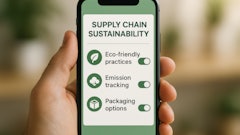
The UN’s recently released climate impact report concluded that the world is set to see some devastating impacts of climate change, signaling a “red alert” for humanity. This wake-up call provides an overwhelming urgency for both individuals and businesses to make drastic changes to help the environment.
When tackling an issue as extensive as environmental sustainability, it is clear that no individual can go it alone. It requires a team - one with shared values, common goals and a desire to come together for the greater good. Many businesses have stepped up by pledging to reach carbon neutrality by reducing their carbon footprint and energy consumption in day-to-day operations. While this is a much-needed step, to truly make a difference, they must look at the bigger picture to maximize their impact through teamwork. By extending their focus beyond what they are doing within their own companies to help the environment, procurement leaders can broaden the reach of their corporate ecological efforts by reevaluating their current processes and teaming with their trading partners to embed sustainable business practices throughout their supply chain.
Teamwork is selfless. It focuses entirely on the end goal, but this doesn’t mean it can’t also be beneficial for each member individually. When based on a foundation of common sustainability values, mutual trust and clear communication, the value of the team can extend beyond common environmental goals to further advance the success of all team members. To achieve this, the right team must be assembled. This will ultimately be the most critical component in both the procurement and sustainability strategies. Within the team, it is crucial to maintain total visibility into not only direct suppliers, but also by extension, their suppliers and trading partners, in order to assess, monitor and mitigate environmental risks across the entire supply base. This level of transparency will enable the team to both prevent supply chain disruptions and meet shared environmental sustainability goals.
Once this dream team is assembled, it’s time for a solid game plan. Sustainability can no longer be treated as an afterthought. It must be a major factor in the overall strategy and play an integral role in the day-to-day decisions and activities that keep the supply chain running. Procurement professionals must create a long-term strategy that considers sustainability in every process from start to finish. New and emerging solutions are being designed to enable these long-term plans, but executives should not overlook more mainstream technologies such as procurement digitalization in the cloud, which brings both environmental advantages, such as a reduced carbon footprint, as well as significant improvements within business processes. By investing in core procurement technology at even the most basic level, businesses achieve much greater benefits in operational efficiencies, cost savings, compliance, transaction accuracy and increased visibility into supply chain processes.
Click here to hear more about sustainability in the supply chain:
The three Rs of sustainability: Responsibility, risk and reward
As any successful coach will attest, motivating a team is essential. Recognizing the importance of sustainability is not the same as incorporating sustainable practices into the end-to-end process. A recent survey conducted by SAP and Oxford Economics found that executives are just beginning to close the gap between goal setting and taking meaningful actions to increase sustainability in their supply chain processes. Each member of the team must acknowledge their role in environmental sustainability efforts and take action. Every member has a responsibility to comply with the team’s high ethical standards and adhere to sustainable business practices in order to move towards a sustainable future for individuals and businesses alike. In essence sustainability should be at the core of every business’ strategy.
In the past, many corporate environmental efforts were viewed as “greenwashing” - checking the box to capitalize on tax write-offs offered by regulatory agencies and potentially some positive PR. However, in recent years, the heightened focus on the visible effects of climate change has escalated this issue beyond federal regulators to employees, investors and customers.
There is significant risk for companies that don’t take action. According to one SAP study, 80% of consumers in emerging markets will pay a premium for goods from companies that actively work to reduce their environmental footprint. Consumers and investors are no longer satisfied by merely cosmetic approaches to sustainability and are actively hostile to anything they see as greenwashing. The potential for lost investment opportunities and market share should be enough incentive for businesses to get on board or get left behind.
Now the third R - reward, which serves as the greatest motivation for taking the team approach. Sustainability is good for both the environment and business. In addition to being good corporate citizens and helping to preserve the environment for future generations, taking the necessary steps to embed sustainability into supply chain processes through the use of digital technology will result in reduced costs and increased business process efficiencies for any business. This technology enables total visibility and transparency throughout end-to-end supply chain processes, simplifying and standardizing interactions and collaboration with suppliers, moving from merely communicating to sharing data and converting this data into business insights. A true win-win, as team members can utilize these actionable insights to achieve improved business results while driving their environmental policies.
The desired end game
When it comes to driving sustainability, accountability lies with executive boards. And, out of all corporate functions, procurement is best suited to help the board succeed in its efforts. After all, procurement’s responsibilities touch nearly every aspect of the supply chain from travel and expense to the decision to utilize renewable energy sources. There is even new technology being introduced that can increase transparency by calculating the carbon footprint across the supply chain by product requisition. Reporting at this level can drive significant change by informing decisions across the entire value chain.
Ultimately, by activating their team of trading partners, procurement teams have the ability to turn their organization’s sustainability challenges into opportunities to foster a durable supply chain that’s more future-proof, rally employees around a core purpose, protect and build their brand reputation, and satisfy consumer and investor demands. The desired end game of this holistic approach is to foster a culture where each team member takes their environmental impact into account with every business decision throughout the value chain. This type of teamwork is required for maximum impact.


















